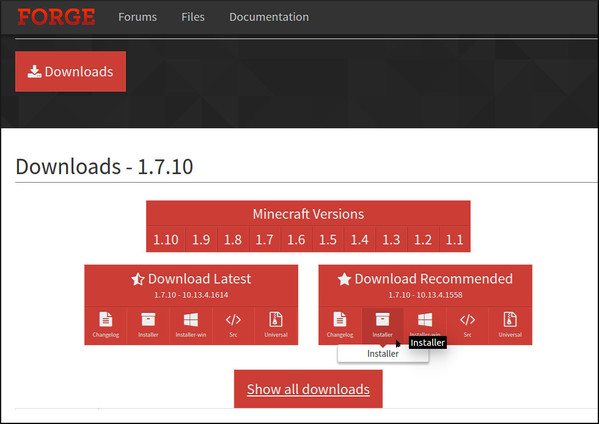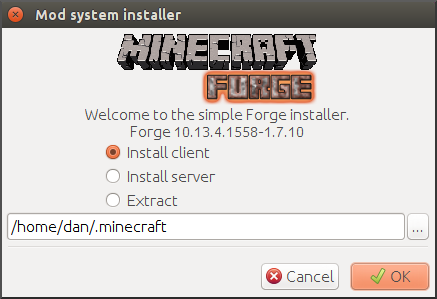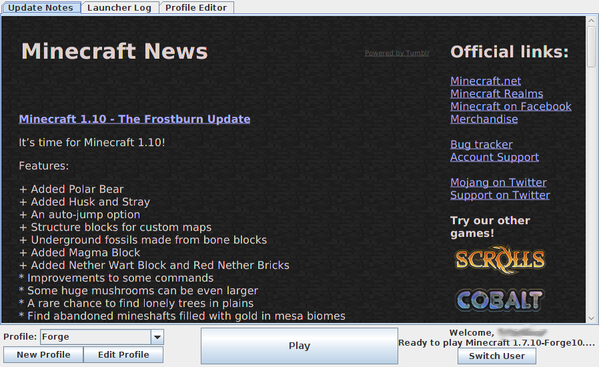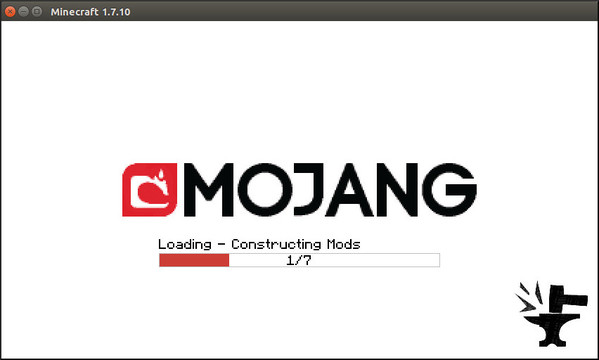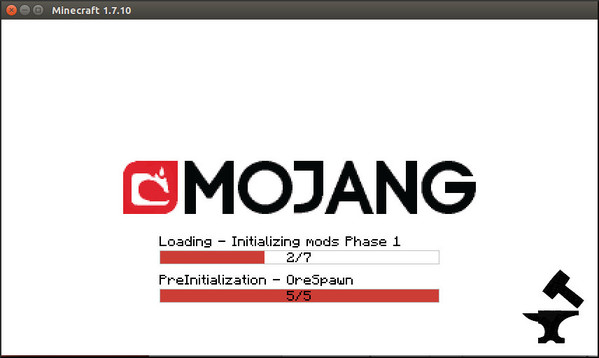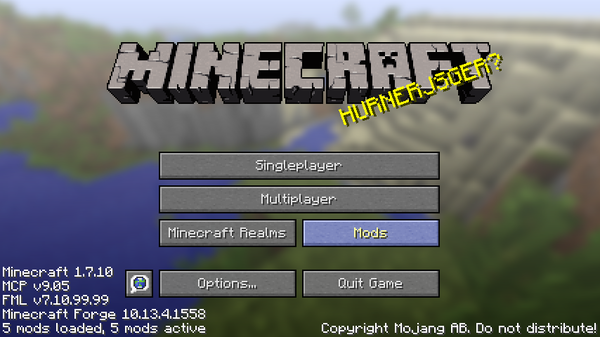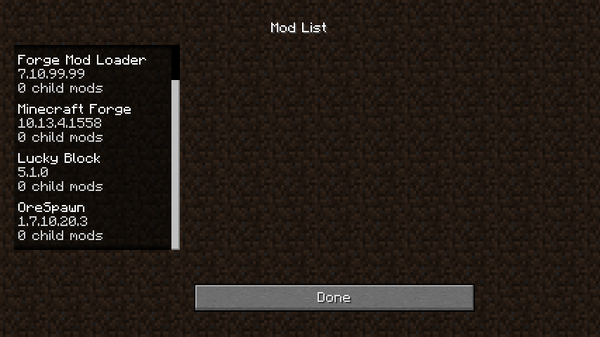Minecraft Forums
[How To]: Install Minecraft & Basic Modding on Linux/Ubuntu
- Out of the Water
- Location: Oklahoma City
- Join Date: 11/18/2012
- Posts: 8
- Minecraft: battleof3
- Xbox: NiarcWriter2001
- Member Details
The following is a guide to installing Minecraft on Ubuntu, I did these exact steps on my Ubuntu 12.04 laptop, and MInecraft works perfectly. If you have an older version of Ubuntu, you can check an older guide on the forums. I apologize, but I don’t have the link to the guide.
So, first-off I’d like to clear up the fact that I understand that there are a couple other posts similar to this one, but from what I looked at, they are outdated. It’s Minecraft 1.5.2 now and things have changed a bit, along with some new features on Ubuntu.
Obviously, to get started, you need to go to https://www.minecraft.net and either log in, then go to their «Downloads» section, or just go straight to their downloads. Then you should click on the download under «Linux/Other.» (If you do not see the heading «Linux/Other,» then you should see a text highlighted in blue saying «Show all platforms,» click it, then you will see the «Linux/Other» download.) Next, there will be a window that pops up asking you if you want to open or save the file. Select the line saying «Save File.»
Now you have installed the minecraft.jar. This alone might work for some of you, but if not, then you need to install «OpenJDK Java 6 Runtime.» You might be thinking to yourself «But isn’t there a Java 7 Runtime?» The answer to that is yes, but for whatever reason, it will not work for launching Minecraft. To install the Java 6 Runtime, you need to open up the Ubuntu Software Center and search «OpenJDK Java 6 Runtime.» If this pulls up 2 different Runtimes, make sure to install the Java 6 Runtime. Now that you have Java 6 Runtime, you can open Minecraft. If you don’t have a shortcut to the minecraft.jar, then you can make one by going to your Home Folder, then going to Downloads, then by right clicking on the minecraft.jar located in your Downloads and selecting the «Copy» button. Then you can close your Home Folder, and right click anywhere on your desktop, and select the «Paste» button. Now, to open the Minecraft Launcher, you’ll need to open the minecraft.jar with OpenJDK Java 6 Runtime. To do this, you’ll need to right click the minecraft.jar on your desktop, click «Open With Other Application,» and the click «Show Other Applications,» then find and select «OpenJDK Java 6 Runtime.» This will bring up the Minecraft Launcher. You’ll then need to type in your username and password, then click «Login.» Then the .minecraft folder will be installed, of course being up-to-date. (Keep in mind that the system requirements for Minecraft on Linux are a bit lower than the system requirements of Windows. So, if you switched to Linux or Ubuntu from WIndows, and you could hold Minecraft on Windows without problems, then Minecraft will run just fine on your Linux/Ubuntu.) From here on out, you can go ahead and set up a new world, server, etc.
Now we’re on to the fun part — modding. If you’ve had Windows before, then modding on Linux or Ubuntu is just about the same as modding on Windows, the only difference is the location of the files and folders you need to access. Infact, in my opinion, modding on Ubuntu is much easier than modding on Windows.
So, to get started with most mods, you’ll need one of two things; ModLoader, or Forge ModLoader. I personally prefer the less complicated, more stable ModLoader. The only problem with ModLoader is that more of the more appealing mods out there require Forge instead. Either way, the installation for both of these programs is the same, and they’re both very simple to install.
Below there are two step-by-step guides, one for ModLoader, and one for Forge Modloader.
- First, you’ll need to go to the Minecraft Forge website (https:/ /www.minecraftforge.net/forum/)
- Next, you want to go to the «Files» section (http://www.minecraftforge.net/forum/index.php?action=files)
- Then you want to choose between the latest Universal or the Recommended Universal. It is important that you get Universal. I would suggest that you get the recommended Universal, as it is much more stable.
- Now save the file, and exit the Forge site.
- Next, you’ll need to go to the Home Folder, then go to Downloads, and right-click the Minecraft Forge file you downloaded, and select «Open With Archive Manager.»
- Now go back to the Home Folder, and press Ctrl+H to view your hidden files and folders. Locate the .minecraft folder and open it, then go to bin and right click the «minecraft.jar» folder and select «Open With Archive Manager.»
- Now you’ll want to go back to the Forge archive and click one of the files, then press Ctrl+A to select all of the files. then you will want to click and hold any of the files and drag them to the minecraft.jar archive.
- Next, you MUST DELETE THE META-INF FILE!*
- Now close the minecraft.jar archive and the Forge archive.
When installing mods that require Forge, you’ll need to go to the .minecraft folder and drag the downloaded mod into the «mods» folder. If you don’t have a «mods» folder, then right-click any empty space in the .minecraft foler and select «Create New Folder,» and name the folder «mods.»
*You must delete the META-INF file AFTER dragging the Forge files into the minecraft.jar!
- First, you’ll want to go to the «Risugami’s Mods» page. (http://www.minecraftforum.net/topic/75440-v152-risugamis-mods-updated/)
- Next, you’ll need to find ModLoader, it should be the first mod on the page.
- Click on either the » Download (Direct) » button or the » Download (Adfly) » button.
- Save the file.
- Now go to the Home Folder, then to Downloads.
- Right-click the Mod-Loader file that you downloaded, and select «Open With Archive Manager.»
- Next, you’ll need to go back to the Home Folder, and press Ctrl+H to view your hidden files and folders. Find and open the folder called «.minecraft»
- Open the «bin» folder.
- Right click the minecraft.jar, then select «Open With Archive Manager.»
- Now click one of the files in the ModLoader’s archive, then press Ctrl+A to select all of the files.
- Drag the files into the minecraft.jar’s archive.
- DELETE THE META-INF FOLDER. *
- Close the archives.
When installing mods that require ModLoader, you simply open the mod’s archive and the minecraft.jar’s archive, and drag the mod’s files into the .jar. But make sure the META-INF file is deleted before closing the archives.
*You can delete the META-INF folder before or after putting ModLoader’s files into the minecraft.jar’s archive.
Questions or comments? Leave them in the comments section! I’ll check this post 2-3 times a week, so I’ll answer your questions within the week that they are asked. s are very much appreciated!
Minecraft linux mod loader
Dan Stoner’s Personal Blog, Photos, and More
Welcome to thatlinuxbox.com Saturday, July 15 2023 @ 06:57 AM UTC
How to Install Minecraft Mods on Linux
- Thursday, August 18 2016 @ 07:05 PM UTC
- Contributed by: Dan Stoner
- Views: 119,818
See the «Additional Notes» section near the bottom of this article for more info on installing and running the java version of Minecraft on Linux.
The first thing I noticed when I started looking at Minecraft mods is dependencies. One major dependency to note is the Minecraft version. At the time of this writing the current version of Minecraft is 1.10.x. Many mods required older versions. For example, to run the OreSpawn mod you need to use Minecraft 1.7. Also, you must first install something called Minecraft Forge (minecraftforge.net) or just » Forge» for short, and it must be the version of Forge that matches the specific version of Minecraft you need to run (as required by the mod).
I found the following video helpful since many of the online howtos are either terrible or written for older versions of Minecraft. For example, they talk about modifying the minecraft.jar and files in the .minecraft/bin directory, neither of which exist in recent versions of Minecraft. I learned from the video that installing Forge and compatible mods is actually embarassingly easy. There is no unzipping or modifying .jar files or deleting META_INF from inside archives, etc.

Here is a summary of the steps that I use to install Minecraft mods on Linux:
1. Download and Run the Forge Installer
In my case I want to run mods that are compatible with Minecraft 1.7. So I locate and download the «installer» from Forge that matches the desired version.
Beware, the free file hosting sites where the actual downloads live try to trick you in a dozen ways to click on something other than your actual file download.
Once downloaded, we need to «run the jar». On my computer, clicking a .jar file does not execute it (it opens it like an archive instead), so I just run the jar file from the command line which will start the graphical installer.
$ java -jar forge-1.7.10-10.13.4.1558-1.7.10-installer.jar
2. Run Minecraft to verify Forge is properly installed
There should now be a profile named «Forge» available in the lower left list of profiles. Star t Minecraft using the «Forge» profile.
After Minecraft loads at least once with Forge installed, it is ok to install the actual mods. Exit Minecraft.
3. Download and install mods
Download the mods and place them in the .minecraft/mods directory. Other than being very careful to download a legitimate mod file and navigating the download sites carefully. that’s it! The mod files that go into «mods» may be either .zip or .jar format.
4. Run Minecraft with the new mods installed
Again start Minecraft and choose the «Forge» profile. Forge will notice the new files in the mods directory and do some additional work to prepare them:
Once Minecraft starts there will be evidence of loaded mods in the bottom left:
Clicking on the «Mods» button will give more detailed information about the mods that are loaded. Here we see that we successfully loaded OreSpawn and Lucky Block.
Additional Notes on setting up Java and Minecraft on Linux
I have had the best luck running Minecraft on Linux by using Oracle Java from http://java.com (the 64-bit .tar.gz download). The following notes lead to the desired behavior of the «java» command being available.
To install or update java, the extracted tar.gz from Oracle goes under /usr/local/ and the symlink in /usr/local/bin is updated so «java» points to the new binary.
At the time of this writing, the latest version from Oracle’s website was Version 8 Update 101. Downloading the file labled «Linux x64» put a file named jre-8u101-linux-x64.tar.gz in my Downloads directory.
$ tar -xvzf jre-8u101-linux-x64.tar.gz
jre1.8.0_101/
jre1.8.0_101/THIRDPARTYLICENSEREADME-JAVAFX.txt
jre1.8.0_101/THIRDPARTYLICENSEREADME.txt
jre1.8.0_101/lib/
jre1.8.0_101/lib/flavormap.properties
jre1.8.0_101/lib/jexec
.
$ sudo mv jre1.8.0_101/ /usr/local/
$ sudo rm /usr/local/bin/java # if we are replacing the existing version
$ sudo ln -s /usr/local/jre1.8.0_101/bin/java /usr/local/bin/java
$ ls -la /usr/local/bin/java
lrwxrwxrwx 1 root root 32 Aug 3 20:46 /usr/local/bin/java -> /usr/local/jre1.8.0_101/bin/java
This is how the system will look after java is in the executables path:
$ which java
/usr/local/bin/java
Confirm that the latest version of java is available to the system with the -version paramenter (single hyphen):
$ java -version
java version «1.8.0_101»
Java(TM) SE Runtime Environment (build 1.8.0_101-b13)
Java HotSpot(TM) 64-Bit Server VM (build 25.101-b13, mixed mode)
To run Minecraft from the command line, I use the Minecraft.jar that was downloaded from Mojang’s website.
$ java -jar Downloads/Minecraft.jar
On first run, this creates a .minecraft folder in one’s user profile directory and will download the actual minecraft launcher and other files under the .minecraft directory. Mods, profiles, settings, and everything else will go under the .minecraft directory.
I actually usually make a .desktop or launcher file so I have an easy clickable icon for starting Minecraft from the desktop (how to do this depends on which particular Linux distro is being used and is beyond the scope of this article).
Once base Minecraft has run successfully on the system, the instructions at the top of this article can be used for installing mods.

